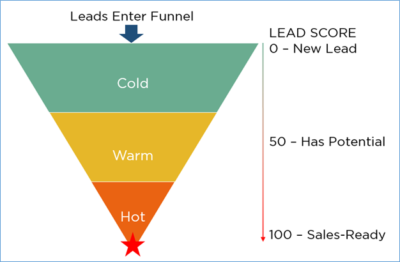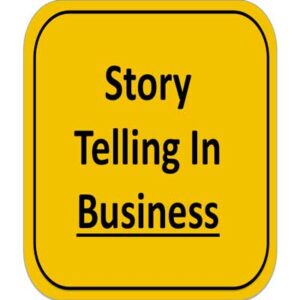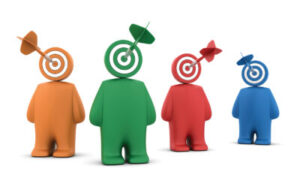Leads are the lifeblood of any business. In order to have a successful business you need paying customers, and in order to get customers you have to generate leads.
Think about a typical bricks and mortar retail store on the high street. If the retail shop is situated on a busy high street with lots of footfall then they are more likely to get more people visiting their store compared to a store that is situated in an area with no people.
Let’s say you have a store on a busy street like Oxford Street in central London. Oxford Street is the busiest shopping street in Europe. There are approx 300 hundred stores along the street which attracts half a million people every single day.
If you owned a store on Oxford Street, you would have 500,000 people potentially walking past your store every single day. But that doesn’t mean every single person who walks past your store will enter your store and buy something. They are all different, and the majority will not all be interested in you or your product or service.
The 3 types of leads
For simplicity, you can say there are 3 types of leads – cold, warm, and hot.
Let’s see how these 3 types of people or leads act when they walk by your store:
1. Cold leads
These are people that will walk past without even glancing at your store. These people are not aware of your store and are not interested in what you’re selling.
They may look at your window front to see what merchandise you have but they have no intention of going in or buying anything. These are the hardest people to convert into customers because they are not necessarily in your target market.
They are unqualified prospects.
2. Warm leads
These types of people may be interested in what you’re selling and may come in to have a look around. These people may potentially see something that they like and make a note of your store with the intention of visiting again or visiting your website.
These can be classified as warm customers or leads because they are aware of your brand and products and are in the market for such, but are not ready to make a buying decision.
They are qualified prospects who aren’t ready to buy yet.
3. Hot leads
These are the people who are aware of your store, your brand, or the merchandise you sell and they have come specifically to buy something. They know what they want and they come in to get it.
These can be classified as hot customers or leads because they are in full buying mode – they know what they want and they have come with credit cards in hand ready to buy now. They may also be repeat customers who are frequent buyers of your products.
They are qualified leads who are ready to buy.
How different leads behave
These customer lead types are also applicable to online businesses, there is no difference.
Just like the example above, cold leads are furthest away from knowing and buying from you. Warm leads are those that are open to hearing about you and buying from you, whilst hot leads are people that know you, want to buy from you or have brought from you previously.
Examples:
Let’s have a look at each lead type and how they differ in their search intent. Let’s say you sell a back pain solution called “Ultra Back Pain Relief.” We will take a look at how someone in your target market may act at each stage:
How cold leads behave:
These people are suffering and want some more information on the subject of back pain or the symptoms they are experiencing. They are not aware of any solutions or products that may help their situation. They are in the research phase not the buying phase.
They will search for general terms like:
- “back pain”
- “why is my back hurting?”
- “how to alleviate back pain”
- “why have I got a shooting pain down my leg?”
How warm leads behave:
These people are aware of their problems and are actively searching for a solution. They are in the research phase. They may even know your brand or have heard of you but are looking for more information on your product and your competitors.
They will typically search for terms like:
- “back pain solutions”
- “best solutions for back pain”
- “Ultra Back Pain Relief reviews”
- “back pain solution on the market”
How hot leads behave:
These people have heard of you and have passed through the research phase and are ready to buy.
Typical search terms include:
- “Ultra Back Pain Relief”
- “buy Ultra Back Pain Relief”
- “Ultra Back Pain Relief delivery”
Marketing to leads at each stage of the sales funnel
Your job as a marketer is to tailor your communication to each type of lead so that you take them from being a cold lead to a warm lead.
It’s no good showing ads for offers on your product to someone in the cold phase as they are not currently in the market for a solution. It’s too early for them and they are still in the phase of understanding their problem.
Marketing to cold leads
Cold leads are not yet looking for the solution or even aware that a solution exists.
What they are aware of is that they have a problem, but they may not necessarily know exactly what that problem is. They just know that something isn’t quite right.
To speak to this type of traffic you start with the problem in your marketing messages. This means clearly stating the problem in your headlines and sales copy.
Example:
- “Are you suffering from sharp shooting pain down your leg?”
- “Are you experiencing pain in your lower back?”
- “If you find it difficult to walk without pain you may be suffering from more serious back problems”
These headlines educate those people who are aware of the symptoms (sharp shooting pain, difficulty moving freely, etc) and lets them know that the reason they have these problems is because they have problems in their back.
This will grab their attention and increase the chances of them clicking on your ad or call-to-action.
Marketing to warm leads
Warm leads are in the research phase. They are aware of the problem and are actively looking for the best solution or an end result. For warm traffic, you should target them with the solution or result that they are after, which in this case is a solution to their back pain.
Example:
- “Want to get rid of back pain fast?
- “Get rid of back pain without having to undergo surgery”
- “Discover the best back pain solution on the market”
Marketing to hot leads
Hot leads are aware of your product, are keen to find out more specifically about purchase details like delivery etc and are ready to buy.
As hot leads are familiar with your product or brand name you should use these attributes in your marketing and sales copy.
Example:
- “Buy Ultra Back Pain Relief and get free delivery”
- “ Find out why Ultra Back Pain Relieve” is recommended by doctors as the best solution on the market”
- “Buy Ultra Back Pain Relief and get free delivery”
- “Find out what our customers say about Ultra Back Pain Relief “
So you can see how the different types of leads or traffic differ from each other and how you need to adapt your communication approach to successfully target each type.
What each lead is looking for
At each stage of the funnel, each type of lead is at a different stage of awareness in their buying journey. Understanding where each lead type is at and what they are looking for at each stage is important so that you can cater for their needs at each stage until they are ready to buy.
What cold leads want
Cold leads want more information about the problem so it’s your job to educate them. You are not selling anything to them at this stage, you are simply providing value through valuable information. This may take the form of a few articles on your blog or website, or a video about back pain and the surrounding issues.
You want to be of service to them. Provide them with great information such as the causes of back pain, how to prevent back pain and some exercises they can do to alleviate the pain. You can then have a link or introduction to your product or maybe a review of your product within this content, but you are not doing any hard selling at this stage.
Your goal is to be helpful and establish yourself as a trusted source of information or an authority in your market by giving them valuable information about the problem.
What warm leads want
Warm leads want more information about the solutions on the market and are typically in review mode. They want to be able to review and compare the current solutions on the market. They may be aware of your product or your competitors, or looking for solutions in general.
For warm leads, you can provide a product comparison between your product and your competitors. Comparison charts and tables work great for this as they can convey a lot of information in an easy-to-digest manner. You are now starting to sell the pros of your product over your competitors, yet you are still providing value by making the comparison and decision-making process easier for them.
Providing reviews, testimonials and other forms of social proof is another great way of establishing confidence and trust in your product and motivating them to move to the next phase of the funnel which is to make a buying decision.
What hot leads want
Hot leads are aware of your product and they are ready to buy.
They may be interested in finding out a bit more about your product such as how it stacks up against other products on the market, so there is a bit of an overlap with warm leads in that sense.
But the difference is that those who are doing product comparisons in the hot phase have already made their minds up that they are going to buy a solution for their back pain problem and want to do some further comparisons or find the best deals or offers. Those doing comparisons in the warm phase are still learning about the different solutions on the market and are not yet sure they will buy any of them.
By catering for your leads throughout each phase of your sales funnel from cold to hot, you create a fluid experience for them and successfully move them through your funnel, converting them from being a prospect to becoming a paying customer.
When you understand how each type of lead behaves at each stage, you can create marketing campaigns and sales copy that will be more relevant, and therefore more effective.
The journey from cold lead to hot lead
Not every cold prospect will become a hot lead who is willing to buy your product or service.
But as a very simple example, I want to give you an overview of what a cold lead could go through to become a hot lead. Let’s have a look at how this would play out using our back pain example.
Cold to warm
Someone is suffering from a sharp pain down their legs and lower back every time they move. They aren’t aware of what the problem is so they do a Google search for “shooting pain down leg”.
They see your ad or blog post on the search results – “If you’re suffering from shooting pains in your leg you may have back problems that need to be addressed urgently.” Curiously, they click to find out more and land on your blog post/article/sales page which explains the causes and symptoms of back pain further.
There is also a link to a review of “Ultra Back Pain Relief” which they may click to find out more. Or now they know what their problem is they may return to Google and do a search for “back pain solutions.”
Warm to hot
They now know something they didn’t previously: that their problems are caused by lower back issues, so they may do a new search for “back pain solutions.”
When searching for back pain solutions they may see your ad or reviews for your product “Ultra Back Pain Relief”. This makes them curious to find out more about your product and they start reading about it and researching customer reviews.
They are now aware that your product exists as a possible solution to their problem. They may do another search and compare your product with other competitors on the market to find out more.
Hot and ready to buy
Now they are convinced about the effectiveness of “Ultra Back Pain Relieve” they want to find out where they can buy it, and what offers are available.
They may want to shop around and see if they can get your product for a better price (if you sell on multiple channels) and may be interested in seeing what delivery options you have available.
They are ready to buy and pull out their credit cards to make the purchase.
Nurture your leads
That is a very simplified overview of a hypothetical sales cycle and the process of a lead going from cold to hot, but I wanted to give an overview of how each lead type acts as they move through the different stages of your sales funnel.
In reality, this process may happen over several days, weeks, and months, across multiple devices and at different times. This is where re-marketing ads, and capturing lead contact information such as their email address is vitally important.
Once you have their contact details and permission to market to them you can enter them into a lead nurturing program where you send emails and other communications to keep them informed and eventually move them along your funnel. You can also use re-targeted ads via display, social media ads, video, and PPC channels to target them further.
As long as you understand your target market and understand their thought process at each stage of the funnel, you will be able to create targeted marketing campaigns that successfully cater to each lead type from cold to hot.




